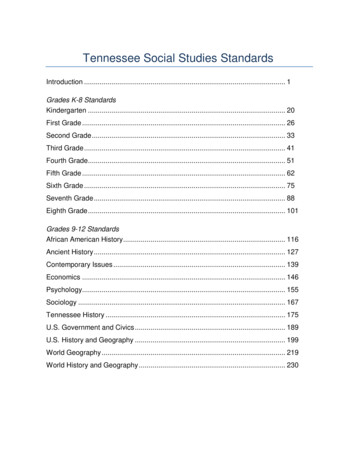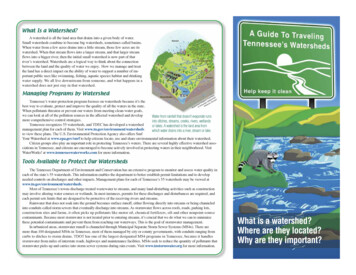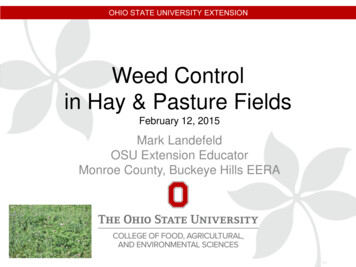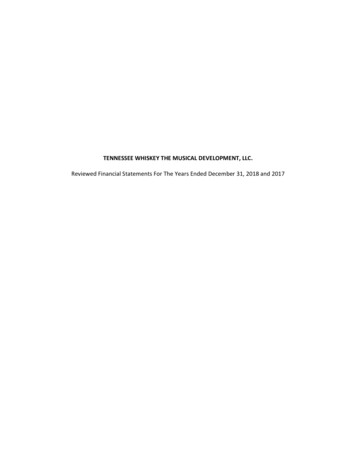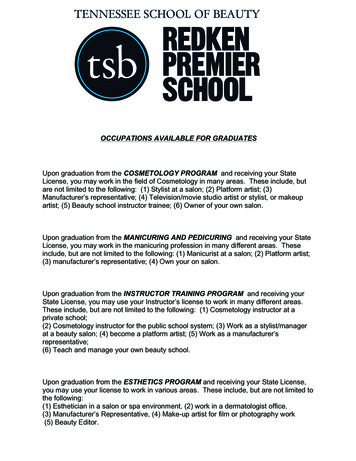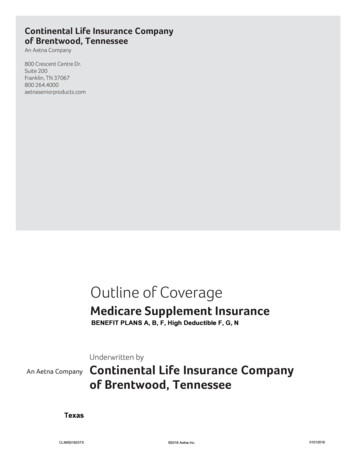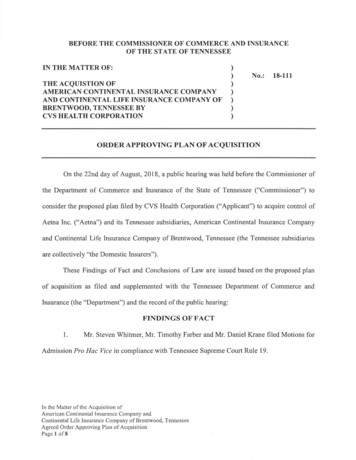
Transcription
Tennessee Grazing Coalition2011 Pasture PlannerDevelop a goal for your operation addressing the energy cycle, water cycle, mineral cycle and community dynamicsBase your decisions on goals, economics, environment and community
Body Condition Scoring (BCS) GuidelinesToo thinTraitCondition Score/ Just Right /Gestation Table Based on 283 Days(Noble Foundation)Too FatVisible Ribs1All2All3Most43-551-260708090Visible Spine NoNoNoNoNoBrisket FatNoNoNoNoNo Tail HeadFat (Pones)Muscle LossNoNoNoNoNoNo NoNoNoNoNoNo In general, if cows are too thin, (condition score 4 or less), they are likely tohave trouble re-breeding and probably need improved grazing or supplement. Cows with 5 BCS may need some additional supplement or high quality pasture Cows rating score 6 or 7 need minimal fall adjustment in management Fat cows, score 8 or 9 are often too fat because they are not pregnant or skippedcalving last year. If she has a good calf and she is pregnant, keep her! indicates an increase or decrease in the trait relative to a 5 BCSRecommended MinimumLevels on Mineral FeedTags for Beef CattleElementLevelCalcium10 to 24%Phosphorus5 to 12%Magnesium2%Magnesium10 to 16%Sulfur1%Manganese2000 ppmCopper1750 ppmZinc3500 ppmCobalt20 ppmIodine50 ppmSelenium44 ppm Mineral supplementationis recommended yearround Calculations based on 24 oz mineral consumption Producers need to switchto a high magnesiummineral at least 60 daysbefore the calving season Sulfur is generally inexcess in TN and can beantagonistic to copper,zinc, iron and -Dec12-Oct30-Apr9-Feb3-Sep15-JunCover photo by USDA/NRCS
Months of 2011
Water Don’t allow trough to overflow, install overflow pipe to drainageway Reduce freezing allow 1/16” of water to flow through trough Ball waterers, set slight gap around balls, drain when not in use Check heat lamps and tightness of pump house Break ice. Painting tank black with 1/2 tank covered reduces freezingHerding Slow down, speak in a normal voice Best if one person calls and anotherkeeps the group together To get livestock to herd up, rearperson should zig zag back and forthat edge of flight (recognition) zone Edge of flight zone is when animalbegins movement Ease in and out of flight zone, applypressure then release pressure Position yourself so the animal cansee you and calf Movement draws movement Direct the lead animal not the rearanimalJanuaryShelter - Cattle in good body condition tolerate cold weather best Wet muddy cattle are most vulnerable to wind and cold Round hay can be strategically placed to provide wind break Living barn is a small clearing facing east surrounded by trees, preferably cedar orevergreenStockpiled grass is 2 to 5 times cheaper than hayRation Pasture like you do hayFeeding/Grazing: Consideradjusting stocking rate toaccumulate forage prior to winterand drought Fall calving is recommended when t.G. Brann, Macon Co.300,000Livestock-Forage Balance by MonthJunForage AvailableMay200,000100,000OctApr.Lb. of Foragefescue is the primary pasture due tobreeding problems Fall calving allows high use of springflush of growth, requires better qualitypasture or hay When conditions are right feed hay inremote areas Unroll hay daily or use hay rings Unrolling hay in front of temp fencereduces waste Ideally locate feed areas 300’ fromwater on uplands surrounded by grass During wet times feed on heavy useareas Baby calves can be trampled aroundhay rDecSepApr.DecNovAug0MonthsLivestock DemandNovSepOctOctJanNovDecFebJanFebMarG. Brann, Macon Co.“Buy light weight calves in late fall after stockpiling grass, sell in August prior to fallgrowth period,” Gordon Hazard (the master of simplicity and net return)
Seeding-Animal Temperament - Cattle with faster exit speeds from the Consider managing existing forage in lieu of seeding more Legumes can improve quality and quantity of forage Renovate with legumes, broadcast/frost seeding. As a mixture/acre: 2 lbs.Ladino white clover, 4 lbs. red clover, plus 8 lbs. of kobe lespedeza on uplandfields. Alone/ac.: 2 lbs. white clover, 8 lbs. red clover, or 25 lbs. of kobe lespedeza Over 30% clover can reduce your stand of grass reducing total production andincreasing chance of bloat (cattle on consistent clover diet less prone to bloat)Feeding Feeding in theafternoon improvesnumber of calves born inthe morning Stockpiled t. fescue canhold good quality for drybeef cattle throughFebruaryworking chute had lower weight gains, more sickness, and more dark cuttingmeat. Cattle with thin foreleg bones exited faster. Holsteins with more whiteon their head exited faster Exit score of animals leaving the working chute1) Walk – have questionable mother ability2) Trot – desirable animal3) Canter – evaluate temperament4) Jump – consider culling or improving temperamentFebruaryThink Clovers,30% of stand isenough Feed on weedy areas &spots of bermuda Do not feed next towater or other sensitiveareas Heavy Use Area runoffinto livestock drinkingwater can cause disease Determine fertilizer andseeding needs based onhay, feed & livestockneedsGrazing Limit graze or fence outstreams/ other sensitiveareas No-tilled winter annualssupport animals better Plan pasture utilization(Water, fence, feed,mineral, shade)G. Brann, Macon Co.USDA/NRCS PhotoFeed on weedy areas to tread weeds down or thin soils to manure area and build organic matter, unrolling hay daily will conserve hay and reducemud outs, another alternative is “bale grazing” set out enough bales for a week and move polywire, feeding daily allowance.
Weed Control - see June for warm season weed control If you are constantly having to spray you need to change mgmt: raise grazing orclipping ht, use high density grazing, more animals on small acreage for shortduration 7 days, rest pastures longer 14 to 45 days, Consider spot spraying weeds, follow label recommendations Multi-species and high density grazing helps control weeds Adding goats and/or sheep to your grazing changes weeds to valuable forbsLivestock Feedmagnesiummineral toprevent grasstetany (seetable) Properphosphorusfertilizationenhances foragemagnesiumuptake andlowers the risk ofgrass tetany Too high soilpotassium cankill cows byincreasing theincidence ofgrass tetany Young learnfrom mother,exposing calvesto feed andforage withmother improvesintake.Fertility –consider cost prior to fertilizing 100 cows on 1 acre for 11 days provides equivalent of150 lbs of 19-19-19 Value of manure from one cow is over 200/ year High density grazing 4 or more animals per acre improves manuredistribution Spread waste hay, mud, and manure from feed areasMarch-Continue to rotate cattle or confine and feed till pastures are at least 6” tall, neveropen up all of the gatesSeeding orRenovation Clean andcalibrate drill Smooth and reseed hay feedingareas and heavytraffic areas Evaluatelegume stands forreseeding Certified redclover seedtypically last 3 yrswhere commononly last 2 yrs Place smallseed at 1/4 to 1/2inch deep Planting toodeep is a commonproblemG. Brann, Macon Co.“Livestock are the ultimate machine, they run on solar energy and reproduce themselves” Greg JudyGrazing- Drought management begins by managing what you have when you have it! Leave residual height of 3” tall fescue & annual ryegrass; 4” orchardgrass & winter annuals Slow down formore preciseseedingWork animals onsides not in frontand rear If rotation stopped during the winter, begin pasture rotation before forage gets ahead of cattle Rotate quickly through pasture, practice take half leave half principle (i.e. 6” at turn in, graze no lower than 3”). Slowly introduce livestock to tall fescue if they come from an area that does not have tall fescue Limit graze winter annuals (winter annuals cost approximately 50.00/ac. less than hay) Consider prescribed burning native grasses, consult Tennessee Division of Forestry for a burn plan & permitPoint ofBalance
Livestock- See Gestation, Body Condition & Mineral Tables Continue feeding magnesium mineral until daytime temperatures are consistently above 60o F Breeding now will give Jan. and early Feb. calves; and reduce problems with high endophyte tall fescue , down side is calving in Jan isn’t working with foragecycle and natural birthing season Use best quality pastures during the breeding season Order of animals nutritional demands: maintenance, lactation, growth, breeding (This is why first calf heifers are hard to rebreed)Grazing Bloat is mostlikely whenlivestock arehungry andturned in on wetlegumesApril-rotate cattle fast when forage growth is fast, alternative is to lay down excessforage with high density grazing improving soil qualityAnimalBehavior High hair whorlsabove the eyes andanimals with nohair whorls aremore flighty Rotate fastwhen growth isfast Tail swishingand a high headare signs of fear 3” stubbleallows t. fescueto capturesunlight for quickre-growth Walking from thehead chute towardanimals in the alleymoves animalstoward the headgate Graze toprevent shadingof legumes Zig zagging infront of the herdslows them down 5” to 8” ofgrass at turn inallows animal toget a mouth full Take halfht./leave half ht.works great forrefreshingtromped onpasture Settle (calm)animals aftermoving them to anew area, allow tograzeG. Brann, Macon CoA single wire cross fence 36” high will allow calves to creep graze ahead of the cows Apply pressureand releasepressure to keepanimals grazing inthe desired areaStock Density (Amount of live weight per acre per day)- Powerful tool, applying pressure to paddocks then turning it off, resting pastures High concentration of animals results in uniform grazing, higher utilization, consumption of weeds, uniform manure distribution and pulsing of nutrients Vary stock density according to forage growth and utilization needs. Stock density can be varied by changing: animal number, weight, and paddock size Target stock densities: Lactating dairy 40,000 lb/ac, Stocker cattle 20,000 lb/ac, Beef cattle 10,000 lb/ac (10-1000 lb cattle/ac) Benefits from high stock density begin about 4000 lbs/ac up to an Ultra-high density of 100,000 lb/ac , rotation is based on height of grass
Native Grasses –best drought tolerance, high productionSeeding- 45 day rest from grazing improves grass production and nesting Typically 30% of the forage system should be in warm season forages Hybrid Bermuda produces high quality forage when tall fescue is dormantrelative to yield Cost share programs are available for establishment Eastern gamagrass, primitive perennial corn Don’t graze Native Warm Season Grass closer than 6” Nesting season for quail is 4/15 -8/15Bermuda grass is an excellent vegetation for heavy use areas Seed, sprig, or vegetatively establish warm season foragesFertility- earliest date to fertilize warm season foragefor alfalfa weevil, treat when 40% of plant tips show damage ScoutOver 32% of fertilizer is wasted if soil pH is 5.5 or lower, too many fields inTennessee are below the desirable pH of 6.5. Soil test!!! Pastures grazed with high stock density typically maintain or improve in fertilityMay-graze tall fescue close (2”)to stimulate existing warm season grassG. Brann, Macon Co.Cattle, Sheep and Goats have different diet preferences, grazing multi-species improve forage utilization and manure distributionCompensatory Gain“The bovine has the ability to exist for months onpractically a maintenance ration and then put on above normal gain as his plain ofnutrition increases. We must keep wintering expenses low using cheap roughagewhile we wait for spring and grass.” Gordon HazardGrazing Continue to rotate fast to keep forage vegetative Now is a good time to heavily graze broomsedge fields Attend NRCS, University, & Ag Dealer pasture walks & field days
Grazing-Parasites- Close grazing stimulatesBermudagrass, crabgrass,dallisgrass Heavy infestation of hornflies can suck a ½ pint of blood per day per steer If their tails are switching and they are using their head to dislodge flies they are not gaining at the maximum Gordon Hazard’s technique is de-worming first with injectable ivermec followed by ivermectin pour on every three months Keep bermuda grazed orclipped short for bestpalatability Separate water, shade andfeed for better animaldistributionJune Johnsongrass, perennialsorghum while not legal tosale in Tennessee is anexcellent forage to manage forCow Days Per Acre # Cows x # Days# AcresNote: 500 lb calf 0.5 cow Totaling cow days per acreper field is powerfulJune Allows comparison ofproduction per fieldconsidering inputs andmanagement See back page for recordingcow days and other recordsWeed Control If you apply pesticides yearafter year, your managementis not breaking the cycle of thepest, the best weed control isgood pasture management High density grazing reducesor eliminates clipping needs Consider spot spraying andwick application of herbicide Consult Extension Serviceand herbicide label for weedsusceptibility, rates and datesof applicationG.G.Brann,MaconCo. Co.Brann,MaconLegumes in warm season grass lower need for costly nitrogen fertilizerFertility Apply fertilizer for warm season forages according to soil test recommendations and forage needs Ideally apply fertilizer prior to 1/2” to 1” rain to reduce fertilizer loss
Grazing System Guidelines Rotate prior to impacting any resource (forage, animal, water, or soil) Follow landscape lines for paddock boundaries Keep paddocks square to rectangular if possible Locate water so paddocks can be further subdivided The paddock ahead should be of higher quality than the one animals are leaving Monthly rotations changed to weekly rotations increases carrying capacity up to 20%Watering Facility-Waterconsumption increases astemperature increases Forage intake drops when waterintake drops Taste of water can reduce intake(sediment, algae, etc)JulyG. Brann, Macon Co.“Overgrazing occurs when a plant bitten severely in the growing season gets bitten severely again while using energy it has taken from itscrown. This occurs three ways: animals stay too long, animals return too soon, or new leaf is removed following dormancy” Alan 34567Days onPaddockPercentRest
Drought Management Inventory grass and predict how long grass will lastWeed Control- Grazing weeds in a vegetative stage increases consumption by cattle; goats Close gates, feed hay or supplement on one field till other fields recovertend to prefer weeds in late season Multiple paddocks conserve forage for slow growth periods, Slow rotation,bigger paddocks longer rest period High density grazing also increases weed consumption Consider creep grazing, allowing calves to graze ahead of cows, or earlyweaning Mowing weeds when blooming before seed forms is best; earlier mowing canresult in tilleringWater-placingwater central infields allowsmaximum options forcross fencingGrazing-Auguststockpile grasson winterfeeding areas Properly planned Mixed forageplacement of waterpoints improvesforage utilization &water qualityspecies pastureallows the animal amore balanced diet,reduces stress,increases intakeand efficiency Herds travel as agroup if traveldistance is over 800–900’ or lead animaltravels over a hill orleaves shade forwater Old disk blade isgreat to cover waterline access or forfloating brace Rotational grazingand proper placementof water improveswaste distribution bythe animal Placing gates orgaps so livestockM. McElroy,enter straightor atCo.Greenea 45- degree angleturn reduces wearof the gate area Most manure isdropped aroundshade, water, andhay. Separating facilitieswill improve manuredistribution Use rack or guard tokeep livestock out ofopen tankG. Brann, Macon Co“Nothing in high density grazing is wasted if it is trampled on the ground. We are feeding our soilmicrobes, earthworms, laying down ground surface litter, building soil, increasing organic matter,preventing erosion, holding water where it falls and providing bird nest habitats” Greg Judy, Mo. Cattle normallygraze 6 to 11 hoursper day, just beforedusk and just afterdawnSeeding- Seed cool season grasses between August 15 and Oct. 1, also good time to apply high density grazing pressure on fields to stimulate seedbank Sow forage for season you lack forage in: Spring, Fall and Winter (tall fescue, orchardgrass, winter annuals), Summer (Bermuda grass, NWSG, millets,sorghums). Most producers need more fall production to carry them farther into winter without feeding hay. Warm season grasses can retain decent quality
Water – the most important nutrientCheck springs during low flow period, may need increased water storage if flow is low, septic tank works greatAnimal’s weight 50-80% water, milk is approximately 90% waterGrazingNormal rumination time is 5 - 9 hours after grazing, adequate rumination indicates a balance of fiber and nutrientsDuring drought confine animals to one paddock or continue to rotate and feed hay till other paddocks recoverDo not graze or clip sericea or native warm season grass fields until after frost unless you want reduced standStockpiling feeding hay duringthe growing seasongrows grass whilefeeding hay, winterfeeding just buystime.September -StockpilingStockpiling is 2 to4.5 times moreprofitable thanfeeding haySteers gain over10% more on highquality waterWater quality canaffect growth,lactation, andreproductionPoor water qualityincreases diseases:Coccidiosis,Cryptosporidia,Salmonella, E. Coliand Leptospirosis.Calves are affectedmostLeptospirosisincreases rates ofabortion within 2-5weeks of infectionStockpile 1ac/cowHoof action stirs upsediment andorganisms loweringwater qualityStockpilingprovides 60 to 90more days ofgrazingTall fescue holdsits winter qualitybetter than anyother perennialforageWater QualityChronic toxicity poor weight gain, poorappetite, highsusceptibility toinfection and abortionStream crossings are best placed above a riffle, not shaded and water diverted from top of ramps.G. Brann, Macon CoGraze riparian areas infrequently (1 or 2 times per year)Seeding- Shape and seed eroded areas, clean out ponds, and perform other earth workThe quality ofstockpiled BermudaInventory existing plants, many times it’s best to manage existing forages, increasing rotation from once perweek to 2x a week improves utilization up to 20%, provides paddocks with 42% more rest for re-growthgrass is not toobad, graze earlyControl weeds and balance fertility prior to seedingafter frostWhen seeding tall fescue seed no more than 1/2 bu. of wheat, best to seed tall fescue aloneStrip grazeSeed tall fescue now and overseed with legumes in Februaryallowing animalsSeed winter annuals in warm season forage or where fescue is less than 50% standaccess to 3 days ofNo-till is an excellent planting method: don’t plant too deep and seedlings must have spaceforage at a timeSulfur causescopper, & seleniumdeficiencyHigh iron in watercontributes to copperdeficiencyTest water ifanimals have a roughhair coat, unexplainedillness, or breedingproblems
Seeding – Overseedwarm season forages likeBermuda grass with red andwhite clover to reduce Nfertilizer by halfGrassfed Meat-OctoberCompared with grain-fedmeat, Grass-fed meats have5 times more cancerfighting CLA {conjugatedlinoleic acid}, Four times morevitamin E, Three times moreheart-friendly omega-3s Twice as much betacarotene. Lower in total fat,saturated fat and calories Fatty acids areessential (fats) in ourdiets The only way to get thecorrect proportions is tochoose grass-fed animalproducts Typically more managementis needed not more seed Seed winter annuals in warmseason forages Fertilize perennial coolseason forages (40 lbs. N) inlieu of overseeding unlessperennial stand is 50% or lessWater-Winterizeequipment, pumps, tanks andbuildings If building a pond install a 2”or larger supply pipe underthe dam with a trough belowthe pondTrailing Trails typically form betweenGrassfed Beef-feed, water and shade Ideal if cattle are in aconstant state of gain of1.8 pounds adg Livestock walk fences andmay create gullies if fencesare located in drainage waysor up & down hill High adg forages TDN65% , 4% of liveweightavailability, 20% DM,balanced energy toprotein ratio 6:1 High density short durationgrazing reduces trailing Access through a gate canmagnify trailing problems For livestock flow, wherepossible place gates incornersG. Brann, Macon Co“Using the Fat Bank, Every fat cow carries an energy reservoir on her back. The energyvalue of one BCS ranges from about one-quarter to one-half ton of hay” Jim Gerrish Spring is best harvesttime G. Brann, Macon Co. Steer finish wt. 100pounds greater than damGrazingConservation Programs Calculate number of cow acre days of grazing left Contact local USDA/NRCS office about available cost share for Number of cows x acres divided by days cow acre days Be aware of prussic acid (cyanide poisoning) from grazing sorghums and johnsongrassafter frost. Grazing is safe 10 days after frost unless re-growth and freezing occurs again Nitrate poisoning, nitrate remains in hay, most common in a drought year, test fornitrates, nitrate concentration is highest in the base of the plant Place weaned calves on rested “clean” grass that is 5” or tallerconservation practices A number of cost share programs are available: CSP, CRP, EQIP,TDA, WHIP and others. Contact TDA for TN Agric. Enhancement program cost share onGenetic Improvement, Cattle Handling Facilities, Hay Storage, MilkEquipment and Marketing Incentives 615-837-5160
Feeding Areas- Feed away from water areas, sinkholes, depressions & other sensitive areasLivestock When possible feed off of heavy use area to improve manure distribution, and lessen cost of spreading Check with Cattleman’s Annual nutrient composition of beef manure: 85 lb. N, 57 lb. P2O5, 190 lb. K20 or (300 lbs. 19-19-19 ) Manure is a benefit spread by the cow on the pasture or it can be a cost and environmental hazard offsite Filter runoff from heavy use areas where manure buildup occurs, 30’ of good pasture filters nutrientsGrazing- If neededbegin strip grazingstockpiled tall fescue atwater pointAssociation and USDA/FSAabout Premise ID It’s easier to put flesh onanimals prior to 3rd trimesterNovember Inventory standingforage available and haysupply Determine standing“Cow Acre Days” After frost, sweetnessand palatability increasein tall fescue Forage will last muchlonger strip grazedallowing animals access toonly 3 to 4 days of grazingat a time Allocate about 2 ac./30head / 3 days: adjustaccording to yield andtrial & error Electric polywire is aconvenient temporaryfence for subdividingpasture If grazing crop residues,leave 50% or more ofsurface covered withresidue, graze in dry timesA good starting point on stocking rate is 1 cow/calf per 2.5 ac. Confine and feed livestock beforeforage is grazed below recommended grazing height. Recommended ending height: Tall fescue 3”,Bermudagrass 2”, Orchardgrass, Small grains 4”, Native Grass 8”. Turn in height 2x or more tallerthan ending height. If livestock have to be confined often stocking rate is too high.
GrazingLivestock- See Gestation, Mineral and Body Condition Score Table Start temporary fence at water source Monitor cows body condition score trend up, down, or stable Strip graze stockpiled tall fescue Although one group is easier to manage, if needed divide the herd into groups for winter feeding Fence off 3 to 4 days of grazing at a time Bury dead animals 30” deep, reduces predator problems Adjust fencing as needed Review the years calf crop and start plans for next years breeding season Winter annuals should be limit grazed Electric tape tied to post, held at other end moves trained animals effectivelyHeavy Use AreasDecember Geo-textile fabric isuseful to improvelongevity of rock Uses include: gates, haystorage, feed pad, streamcrossing, around trough,around barn, etc. Size rock relative to thejob: 2”-3”rock for heavyequipment and haystorage, crusher run isstandard, 3/8” stone tolime for tender feet Backing up whendumping rock preventswadding geotextileG. Brann, Macon CoUnrolling hay daily as needed, reduces or eliminates mud outs, and weedy spots in the growing season, improves accessibility and manuredistribution. TAMU reports feeding 1/3 less hay by rationing hay with an unroller (similar to feeding square bales)Corral Design- crowd pen best w/ level surface, fill pen half full Crowd pen best if animals see 2 to 3 body lengths up the single file chute before it curves Animals go around the curve, thinking they are going back where they came from Width of V-shaped chute is 18” at bottom & 32” at 5’ ht., or 28” width for a straight wall chute Compacting rockimproves utility andlongevity Use a sheep's footroller, hand held packer,or drive over previouslyplaced rock with aloaded truck Maintain rock coverover geotextile
Tennessee Grazing Coalition- partners interested in promoting the benefits of grazing management: Members of the coalition include: Beefand Dairy Grazer, Raymond Cooper, Chairman; Beef and Goat Grazer, Bill Legg, Vice Chairman; Beef Producer, Terry Gupton; Beef andSheep Grazer, Delk Kennedy; TN Association of Conservation Districts, Nelson Garner; TN Cattlemen’s Association, Bud Guinn; TN FarmBureau, John Wolfolk and Flavius Barker; TN Forage and Grassland Council, Perry Neal; TN Goat Producers, Steve and Connie Gillam; TNHorse Council, TN Llama Community, TN Sheep Producers Association, Ben Powell; TN State Agriculture Committee, Glen Long; RuralResources, Sally Causey and Richard Spain. Technical advisors: Natural Resources Conservation Service, Greg Brann and Vic Simpson;Tennessee Department of Agriculture, Jim Nance; The University of Tennessee, Gary Bates; UT Experiment Stations, Dennis Onks; TennesseeState University, An Peischel.Groups Committed to Livestock Production and a Healthy EnvironmentNatural Resources Conservation Service – Grazing Lands Mission: Coordination, and transfer of technology that meets theneeds of grazing land resources, landowners, managers, and the public. Strive to develop Total Resource Management Plans thataddress all resource concerns. Contact local field offices: x.htmlTennessee Association of Conservation Districts: Mission: to take available technical, financial, and educationalresources, whatever their source, and focus or coordinate them so that they meet the needs of the local land user for the conservation ofsoil, water and related resources. http://tnacd.org/Tennessee Beef Cattle Improvement Initiative: Goals: Develop & Implement Marketing Strategies, Provide Producerswith Superior Education Programs, Build Information Networks that Serve Producers' Needs, Identify & Promote Profitable Genetics,Improve Forage Production & Management, Market Consumer-Oriented Beef, Provide Information to Improve Cattle Health, IncreasePolitical Support & Funding for the Tennessee Beef Industry. http://www.tnbeefcattleinitiative.org/Tennessee Cattlemen's Association mission is to provide the cattle feeders and producers in the State of Tennessee with anorganization through which they may function collectively to protect their interests and work toward the solution of cattle industryproblems; and to build the necessary good-will that will bring both governmental and public esteem and recognition to the industry.http://www.tncattle.org/Tennessee Farmers CO-OP remains a cornerstone in the Tennessee communities in which retail outlets and TFC facilities arelocated. Because its roots reach back into the soil farmed by its organizers, Co-op always has the best interest of its patrons at heart. Aknowledgeable, well-trained, and dedicated staff stands ready to serve the needs of each and every customer. Remember: Co-op offersquality products for everyone! http://www.ourcoop.com/main/home.aspThe Nature Conservancy The Duck River is considered a "Last Great Place" by The Nature Conservancy, and is widelyregarded as the most biologically rich river in North America. Our Duck River Project works with a variety of partners and iscommitted to supporting landowners in their efforts to improve land condition and protect water quality throughout the upperwatershed. http://www.nature.org/
Tennessee Department of Agriculture- The goal of TDA s Agricultural Resources Conservation Fund is to reduce oreliminate runoff from agricultural operations to the extent that soil particles or other pollutants do not enter the waters of the state.http://www.state.tn.us/agriculture/Tennessee Farm Bureau Federation- To develop, foster, promote and protect programs for the general welfare, includingeconomic, social, educational and political well-being of farm people of the great state of Tennessee." adopted February 15, ee Landowner Incentive Program (TNLIP)-The TWRA will provide 75% cost-share assistance and some cashincentives for best management practices implemented near streams. Practices will include stream exclusion fencing withalternative water sources, field
Plan pasture utilization (Water, fence, feed, mineral, shade) Feeding Feeding in the afternoon improves number of calves born in the morning Stockpiled t. fescue can hold good quality for dry beef cattle through February Feed on weedy areas & spots of bermuda Do not feed n

